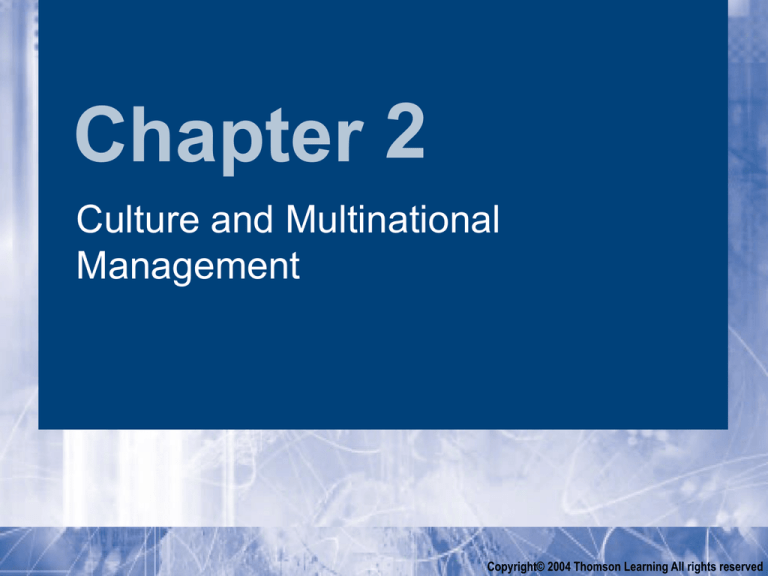
Chapter 2
Culture and Multinational
Management
Copyright© 2004 Thomson Learning All rights reserved
Learning Objectives
• Define culture and understand the basic components
of culture
• Identify instances of cultural stereotyping and
ethnocentrism
• Understand how various levels of culture influence
multinational operations
Copyright© 2005 South-Western/Thomson Learning All rights reserved
Learning Objectives
• Understand the Hofstede and 7d models
• Appreciate the complex differences among cultures
and use these differences for building better
organizations
Copyright© 2005 South-Western/Thomson Learning All rights reserved
What is Culture?
• Pervasive and shared beliefs, norms, values, and
symbols that guide everyday life.
• Cultural norms: both prescribe and proscribe behaviors
• What we should do and what we cannot do.
• Cultural values: what is good/beautiful/holy, and what
are legitimate goals for life.
Copyright© 2005 South-Western/Thomson Learning All rights reserved
What is Culture?
(cont.)
• Cultural beliefs: represent our understandings about
what is true.
• Cultural symbols, stories, and rituals: communicate the
norms, values, and beliefs of a society or a group to its
members.
• Culture is pervasive in society
• Affects all aspects of life
• Not all aspects are observable
Copyright© 2005 South-Western/Thomson Learning All rights reserved
Culture: Front Stage & Back
Stage
• Front stage of culture: easily observable aspect of
culture
• e.g., Japanese executive bows or North American
robust handshake.
• Back stage of culture: only insiders or members of the
culture understand other aspects of culture
• e.g., Japanese saying “it’s difficult” and twisting
head to one side really means it’s impossible.
Copyright© 2005 South-Western/Thomson Learning All rights reserved
Three Levels of Culture
1. National culture: the dominant culture within the
political boundaries of the nation-state.
2. Business culture: norms, values, and beliefs that
pertain to business in a culture.
1. Tells people the correct, acceptable ways to
conduct business in a society.
Copyright© 2005 South-Western/Thomson Learning All rights reserved
Three Levels of Culture
(cont.)
3. Occupational and organizational culture
3.Occupational culture: the norms, values, beliefs, and
expected ways of behaving for people in the same
occupational group.
4.Organizational culture: the set of important
understandings that members of an organization
share.
Copyright© 2005 South-Western/Thomson Learning All rights reserved
Cultural Differences and
Basic Values
• Two diagnostic models to aid the multinational
manager:
1. Hofstede model of national culture
2. 7d culture model
Copyright© 2005 South-Western/Thomson Learning All rights reserved
Hofstede’s Model of National
Culture
• Five dimensions of basic values
• Power distance
• Uncertainty avoidance
• Individualism
• Masculinity
• Long-term orientation
Copyright© 2005 South-Western/Thomson Learning All rights reserved
Hofstede’s Model Applied to
Organizations and
Management
• Management practices considered in the discussion of
Hofstede’s model include:
1.Human resources management
• Management selection
• Training
• Evaluation and promotion
• Remuneration
Copyright© 2005 South-Western/Thomson Learning All rights reserved
Hofstede’s Model Applied to
Organizations and
Management (cont.)
2.Leadership styles
3.Motivational assumptions
4.Decision making and organizational design
5.Strategy
Copyright© 2005 South-Western/Thomson Learning All rights reserved
Power Distance
• Power distance concerns how cultures deal with
inequality and focuses on
• Norms that tell superiors (e.g., bosses) how much
they can determine the behavior of their
subordinates
• Values and beliefs that superiors and subordinates
are different kinds of people
Copyright© 2005 South-Western/Thomson Learning All rights reserved
Power Distance (cont.)
• High power distance countries have norms, values,
and beliefs such as
• Inequality is fundamentally good
• Everyone has a place: some are high, some are low
• Most people should be dependent on a leader
• The powerful are entitled to privileges
• The powerful should not hide their power
Copyright© 2005 South-Western/Thomson Learning All rights reserved
Exhibit 2.2: Managerial
Implications for Power
Distance
Copyright© 2005 South-Western/Thomson Learning All rights reserved
Uncertainty Avoidance
• Norms, values, and beliefs regarding tolerance for
ambiguity
• Conflict should be avoided
• Deviant people and ideas should not be tolerated
• Laws are very important and should be followed
• Experts and authorities are usually correct
• Consensus is important
Copyright© 2005 South-Western/Thomson Learning All rights reserved
Exhibit 2.3: Managerial
Implications of Uncertainty
Avoidance
Copyright© 2005 South-Western/Thomson Learning All rights reserved
Individualism/Collectivism
• Focus is on the relationship between the individual and
the group
• Countries high on individualism have norms, values,
and beliefs such as
• People are responsible for themselves.
• Individual achievement is ideal.
• People need not be emotionally dependent on
organizations or groups.
Copyright© 2005 South-Western/Thomson Learning All rights reserved
Individualism/Collectivism
• Collectivist countries have norms, values, and beliefs
such as
• One’s identity is based on group membership.
• Group decision making is best.
• Groups protect individuals in exchange for their
loyalty to the group.
Copyright© 2005 South-Western/Thomson Learning All rights reserved
Exhibit 2.4: Managerial
Implications of
Individualism/Collectivism
Copyright© 2005 South-Western/Thomson Learning All rights reserved
Masculinity
• Tendency of a culture to support traditional masculine
orientation
• High masculinity countries have beliefs such as
• Gender roles should be clearly distinguished.
• Men are assertive and dominant.
• Machismo/exaggerated maleness in men is good.
• Men should be decisive.
• Work takes priority over other duties.
• Advancement, success, and money are important.
Copyright© 2005 South-Western/Thomson Learning All rights reserved
Exhibit 2.5: Managerial
Implications of Masculinity
Copyright© 2005 South-Western/Thomson Learning All rights reserved
Long-Term Orientation
•
•
•
•
•
•
Belief in substantial savings
Willingness to invest
Acceptance of slow results
Persistence to achieve goals
Sensitivity to social relationships
Pragmatic adaptation
Copyright© 2005 South-Western/Thomson Learning All rights reserved
Exhibit 2.6: Managerial
Implications of Long-term
Orientation
Copyright© 2005 South-Western/Thomson Learning All rights reserved
Exhibit 2.7 Hofstede’s
Classification of Countries by
Clusters
Copyright© 2005 South-Western/Thomson Learning All rights reserved
Exhibit 2.7 Hofstede’s
Classification of Countries by
Clusters
Copyright© 2005 South-Western/Thomson Learning All rights reserved
7d Cultural Dimensions Model
• Builds on traditional anthropological approaches to
understanding culture
• Culture exists because people need to solve basic
problems of survival
• Challenges include
• How people relate to others
• How people relate to time
• How people relate to their environment
Copyright© 2005 South-Western/Thomson Learning All rights reserved
7d Cultural Dimensions Model
(cont.)
• Dimensions that deal with relationships include:
• Universalism vs. Particularism
• Collectivism vs. Individualism
• Neutral vs. Affective
• Diffuse vs. Specific
• Achievement vs. Ascription
Copyright© 2005 South-Western/Thomson Learning All rights reserved
7d Cultural Dimension Model
(cont.)
• Dimensions dealing with how a culture manages time
and how it deals with nature
• Sequential vs. Synchronic
• Internal vs. External control
Copyright© 2005 South-Western/Thomson Learning All rights reserved
Exhibit 2.8: The 7d Model of
Culture
Copyright© 2005 South-Western/Thomson Learning All rights reserved
Universalism vs. Particularism
• Pertain to how people treat each other based on rules
or personal relationships
• Universalistic
• Right way is based on abstract principles such as
rules, law, religion
• Particularistic
• Each judgment represents unique situation that can
be dealt with based on relationships
Copyright© 2005 South-Western/Thomson Learning All rights reserved
Exhibit 2.9: Managerial
Implications for Universalism
vs Particularism
Copyright© 2005 South-Western/Thomson Learning All rights reserved
Individualism vs. Collectivism
• Similar distinctions to Hofstede’s view
• Collectivist societies
• People defined by group memberships such as
family
• Responsibility, achievement, and rewards are
group-based
• Individualist societies
• People trained to be independent
• Assume individual responsibility for success or
failure
Copyright© 2005 South-Western/Thomson Learning All rights reserved
Exhibit 2.10: Managerial
Implications of
Individualism/Collectivism
Copyright© 2005 South-Western/Thomson Learning All rights reserved
Neutral vs. Affective
• Concerns acceptability of expressing emotions
• Neutral
• Interactions are objective and detached
• Focus is on tasks rather than relationships
• Affective
• Emotions are appropriate in all situations
Copyright© 2005 South-Western/Thomson Learning All rights reserved
Exhibit 2.11: Managerial
Implications of Neutral vs.
Affective
Copyright© 2005 South-Western/Thomson Learning All rights reserved
Specific vs. Diffuse
• Extent to which an individual’s life is involved in work
• Specific
• Business segregated from other parts of life
• Contracts often delineate relationships
• Diffuse
• Business relationships encompassing/involving
• Private and segregated space is small
Copyright© 2005 South-Western/Thomson Learning All rights reserved
Exhibit 2.12: Managerial
Implications of Specific vs.
Diffuse
Copyright© 2005 South-Western/Thomson Learning All rights reserved
Achievement vs. Ascription
• Manner in which society gives status
• Achievement
• People earn status based on performance and
accomplishments
• Ascription
• Characteristics or associations define status
• E.g., status based on schools or universities
Copyright© 2005 South-Western/Thomson Learning All rights reserved
Exhibit 2.13: Managerial
Implications of Achievement
vs. Ascription
Copyright© 2005 South-Western/Thomson Learning All rights reserved
Time Orientation
• How cultures deal with the past, present, and future
• Future-oriented societies, such as the U.S., consider
organizational change as necessary and beneficial
• Past-oriented societies assume that life is
predetermined based on traditions or will of God
Copyright© 2005 South-Western/Thomson Learning All rights reserved
Exhibit 2.14: Managerial
Implications of Time Horizon
Copyright© 2005 South-Western/Thomson Learning All rights reserved
Internal vs. External Control
• Concerned with beliefs regarding control of one’s fate
• Best reflected with how people interact with the
environment
• Does nature dominate us or do we dominate
nature?
• In societies where people believe nature dominates
them, managers are more fatalistic.
Copyright© 2005 South-Western/Thomson Learning All rights reserved
Exhibit 2.15: Managerial
Implications of Internal vs.
External Control
Copyright© 2005 South-Western/Thomson Learning All rights reserved
Exhibit 2.16: 7d Percentile
Rankings for Selected
Countries
Copyright© 2005 South-Western/Thomson Learning All rights reserved
Exhibit 2.16: 7d Percentile
Rankings for Selected
Countries
Copyright© 2005 South-Western/Thomson Learning All rights reserved
Exhibit 2.16: 7d Percentile
Rankings for Selected
Countries
Copyright© 2005 South-Western/Thomson Learning All rights reserved
Propensity to Trust
• Growing concern with the development of trusting
relationships with partners
• Differences among cultures in terms of how and when
people trust each other
• Logic presupposes that individualism should be related
to low trust
• Individualistic cultures have higher trust relative to
collectivist societies
Copyright© 2005 South-Western/Thomson Learning All rights reserved
Exhibit 2.17: Levels of General
Trust in People
Copyright© 2005 South-Western/Thomson Learning All rights reserved
Exhibit 2.17: Levels of General
Trust in People
Copyright© 2005 South-Western/Thomson Learning All rights reserved
Exhibit 2.17: Levels of General
Trust in People
Copyright© 2005 South-Western/Thomson Learning All rights reserved
Caveats and Cautions
• Stereotyping: assumes that all people within one
culture behave, believe, feel, and act the same.
• Ethnocentrism: occurs when people from one culture
believe that theirs are the only correct norms, values,
and beliefs.
• Cultural relativism: all cultures, no matter how different,
are correct and moral for the people of those cultures.
Copyright© 2005 South-Western/Thomson Learning All rights reserved







